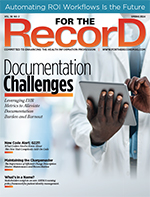Spring  2024 Issue
2024 Issue
CDI: The Evolution of Clinical Documentation
By Keith Loria
For The Record
Vol. 36 No. 2 P. 5
Over the past decade, clinical documentation has experienced some meaningful shifts with the advancement of EHRs and artificial intelligence (AI) tools.
“Today, EHRs help capture over 30,000 data points per hospital visit and generative AI is starting to increase that even more,” says Michael Gao, MD, CEO and cofounder of SmarterDx. “To better sort all of this data, clinical documentation has evolved from an individual effort to complex CDI [clinical documentation integrity] teams and processes with multiple roles—auditors, educators, second-level reviewers—and technology and vendor support.”
With these tens of thousands of data points, hospitals now have a more complete picture of the patient journey than ever before.
However, Gao notes, sometimes that picture is more like a jigsaw puzzle.
“All of the pieces are there, but they’re not necessarily assembled in the right order to tell the full, accurate story,” he says. “Templates, structured documentation tools, defined rules, and AI can help process this avalanche of data for CDI teams, so they can make more informed decisions that positively impact patient and financial health.”
Adding complementary technologies to current CDI and coding systems can enhance revenue without disrupting existing workflows.
“It’s not about replacing people or reinventing workflows; it’s about doing more with the team and workflows you already have,” Gao says.
For instance, at SmarterDx, the technology goes to work after concurrent CDI processes but before billing.
“Roughly 95% of CDI occurs at the concurrent stage, so it doesn’t conflict with any steps within that existing workflow,” Gao explains. “AI can augment the team and workflow by finding missing or incomplete diagnoses in seconds and presenting its findings to the CDI team. Triaging those findings (accept, reject, or physician query) takes just minutes, yet can potentially contribute millions in new revenue.”
Kevin Huffman, DO, says meticulous clinical documentation is the cornerstone of quality patient care today as it’s an essential tool for communication among health care providers.
“Always initiate with accuracy and comprehensiveness in your records—a step that will undoubtedly enhance their efficacy,” he says. “When delving into a patient’s care, it becomes imperative not only to identify symptoms and diagnoses but also include an extensive patient history, findings from meticulously noted physical examinations, as well as articulating the reasoning behind each decision made.”
Informing future care, minimizing errors, and improving patient outcomes all necessitate the painting of a complete picture.
One issue is that clinical documentation presents a complex challenge for vendors, primarily due to the need for highly customized documents tailored to the specific requirements of each physician. The complexity is compounded by the fact that the demands of one medical specialty can vastly differ from those of another.
That’s why more innovation has emerged in recent years to make the process easier.
AI Benefits
AI has been instrumental in transforming clinical documentation, not only simplifying the process but also empowering physicians with advanced tools that significantly enhance their decision-making capabilities. Moreover, the emergence of voice recognition technology marks another leap forward, introducing a new level of efficiency and accessibility in clinical interactions and record-keeping.
As AI advances, it can help drive optimal use of CDI resources and help them assemble that complete picture. For example, AI today can recognize the difference between supplemental oxygen delivered in emergency departments to a tachypneic patient and supplemental oxygen delivered routinely after a surgery and knows to identify only acute respiratory failure in the first instance.
“CDI teams can react to the recommendations and supporting evidence versus sifting through the entire record manually,” Gao says. “This can help CDI teams achieve greater productivity, accuracy, and outcomes as well as reduce revenue loss.”
These technological advancements are poised to streamline the billing process significantly, lessening the dependence on highly specialized billing professionals.
Typically, the nuanced understanding required for accurate billing, especially in specialized fields like emergency medicine, demands experts well-versed in the specific coding intricacies of that domain. However, with the introduction of advanced AI systems, even those with less experience in billing can be guided through the complexities, ensuring precise and efficient billing.
In essence, AI holds the promise of elevating the capabilities of novice billers, bridging the gap between expertise and efficiency in the billing process.
What’s Ahead
There have been more C-suite leaders understanding and supporting clinical documentation initiatives as the industry moves toward value-based care and reimbursement.
“They understand the impact of accurate risk adjustment and quality measures and are making technology investments, particularly into AI, to promote documentation integrity without increasing staff,” Gao says. “Ultimately, higher quality patient records support better decision-making, patient outcomes, and financial health.”
— Keith Loria is a freelance writer based in Oakton, Virginia.



